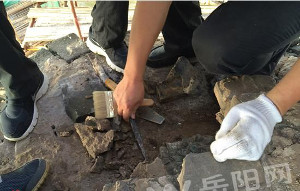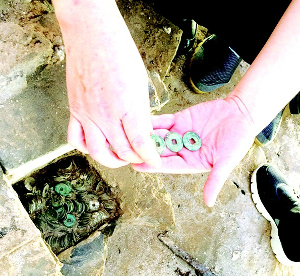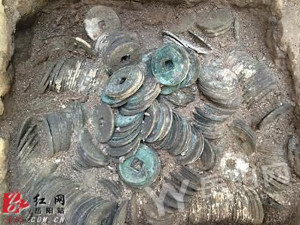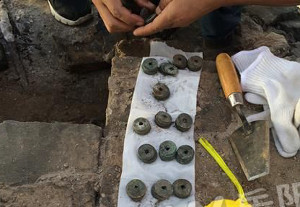
Cishi Pagoda
More than a thousand Tang and Song dynasty coins have been discovered during the restoration of the Cishi Pagoda (cishi ta 慈氏塔) located in Yueyang (岳阳), Hunan Province (湖南省), according to an article in the Yueyang Daily (岳阳日报) dated August 21, 2015.
The Cishi Pagoda is a seven-story, eight-sided (octagonal) brick pagoda 39 meters (128 feet) in height.
It was built during the period 713-714 of the Tang dynasty (618-907) which makes it the oldest surviving structure in Hunan.
A major restoration took place in 1066 (宋代治平年间) during the reign of Emperor Yingzong of the Song dynasty (960-1279).
The date of the original restoration was confirmed when a covered alms bowl with the inscription da song zhi ping san nian (大宋治平三年) was discovered during the current restoration. The inscription translates as “the third year of Zhi Ping of the Great Song” which would be the year 1066.
As can be seen in the image above, the pagoda was in very poor shape prior to the current restoration effort which began in April of this year.

The niche containing the coins can be seen at the left of the worker’s gloved hand.
While working on the second story from the top, workers discovered a cache of more than 1,000 ancient Chinese coins hidden in a square niche.
The niche is about 16 cm on a side and about 25 cm deep.
The image above shows the square niche containing the coins.

Coins being removed from the cache
The image to the left clearly shows the small square niche where the coins were buried for almost 1,000 years.
The cache includes coins dating from the Tang and Song dynasties.
Most of the coins are from the early Northern Song dynasty (960-1126).
According to the newspaper article, the coins include kai yuan tong bao (开元通宝) coins from the Tang dynasty.
These kai yuan tong bao coins are of the variety that were being cast during the earlier years of the Tang.
This is also the variety of the coin which was being minted in the period 713-714 when the pagoda was constructed.
Researchers believe that these coins confirm that the pagoda was originally built during the period 713-714 of the Tang.
Coins discovered from the Song dynasty include:
- chun hua yuan bao (淳化元宝) cast during the years 990-994 of the reign of Emperor Taizong
- xian ping yuan bao (咸平元宝) cast during the years 998-1003 of the reign of Emperor Zhenzong
- tian xi tong bao (天禧通宝) cast during the years 1017-1022 of the reign of Emperor Zhenzong
- tian sheng yuan bao (天圣元宝) cast during the years 1023-1031 of the reign of Emperor Renzong
There is an interesting legend associated with the pagoda.
The pagoda is situated near the eastern shore of Dongting Lake (洞庭湖) which is fed by the Yangze River (Changjiang 长江).
Being a flood basin of the Yangze, the size of the lake varies according to the season.
During the Tang dynasty, the people of Yueyang were afraid of a demon that lived in the waters. The demon caused devastating floods and made the people’s lives miserable.
The pagoda was built to provide protection from this demon and all the people of the village donated funds for its construction.
One family in particular had suffered greatly from the water-dwelling demon. All but one member of the family had drowned in the floods. The only surviving family member was a widow. When she heard that a pagoda was to be built, she donated all of her money to the cause.
Also, every day she would bring tea and water to the workers constructing the pagoda.
Unfortunately, the widow died before the pagoda was completed.
In memory of her sacrifice and giving, the pagoda was named Cishi which translates as “the compassionate”.
Mr. Ou Jifan (欧继凡), the Deputy-Director of the Yueyang Municipal Office of Cultural Relics (市文物管理处副主任), stated that an analysis of the coins confirmed that a major restoration of the pagoda had taken place in 1066 during the Song dynasty.
Mr. Ou also explained that there was a tradition of burying coins during the construction and renovation of pagodas. Coins were believed to offer protection to the pagoda, served as a sacrifice to the heavens, and expressed the hope for peace.
The restoration is scheduled to be completed by the end of 2015.

